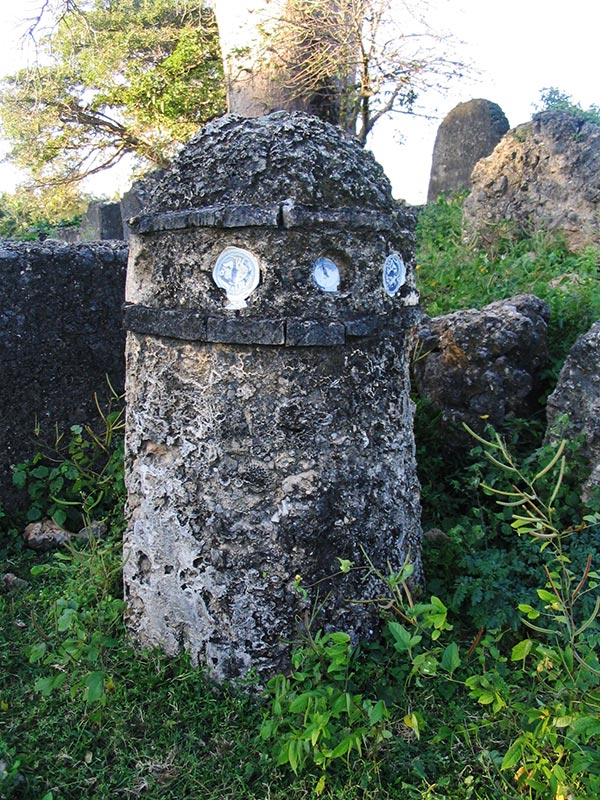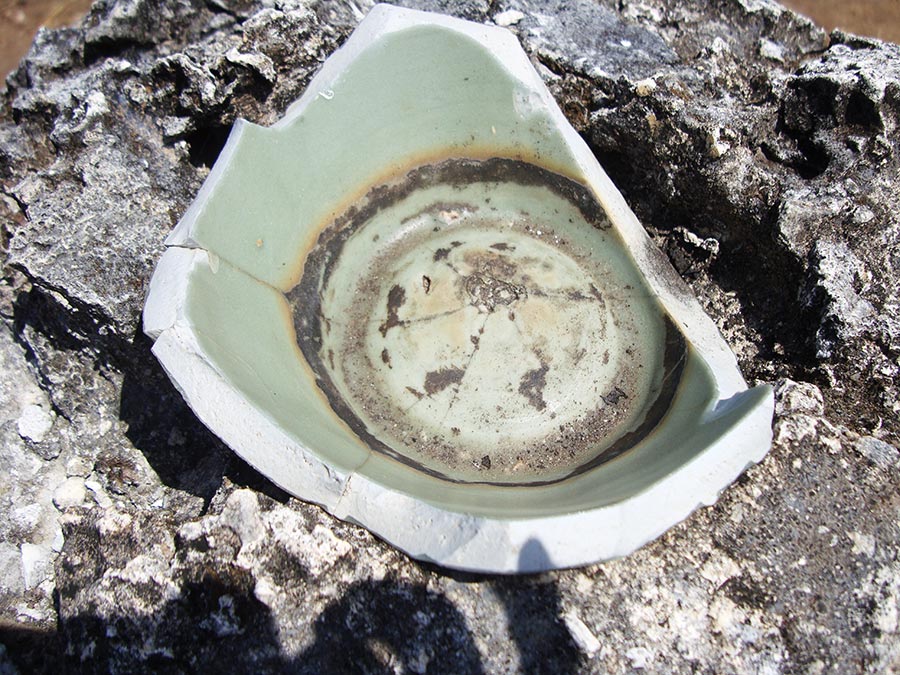Longquan Celadon Found in Kenya
Ceramics are forever being excavated in important sites throughout Eastern Africa, proving the existence of connections and exchanges between this region and ancient China. Longquan celadon, which is the best celadon among ceramics of China, was mainly produced in Longquan, Zhejiang province. Longquan celadon and blue-and-white ware are the most common categories of Chinese ceramics found at these sites. Western archaeologists are continually conducting chronological research at sites based on Chinese ceramics, for which they already have a nearly complete chronological system. Thus, information about Chinese ceramics can be found in most archaeological reports of East African sites. Western researchers rarely pay attention to this information, but it can be used for a more profound analysis of Longquan ware.
In the 1980s, the Chinese researchers Ma Wenkuan and Meng Fanren introduced Chinese ceramics found in Africa, as shown in archaeological reports published in English. Subsequently, archaeologists from Peking University conducted surveys of Chinese ceramics in Kenya from 2010 to 2013, in which I, too, took part. Some research results of the survey have been published. Here I would like to conduct a detailed supplementary analysis of Longquan celadon with the data from two other sites in Kenya, Shanga and Malindi.
The Shanga site is located on the southwest coast of Pate Island, Lamu archipelago. From 1980 to 1988, Mark Horton from Cambridge University excavated there for six seasons, which has provided us with abundant materials. He carried out a statistical study of the different categories of remains, including Chinese ceramics. In Trench 1 and Trenches 6-10, 389 shards of Chinese ceramics were found, including Yue ware, Longquan ware, blue-and-white ware, white porcelain and Changsha ware. The hoard included 230 Longquan shards, or 59% of the Chinese ceramics found in the hoard. In Shanga, the earliest Longquan ware was excavated from the stratum dated 1000 to 1050. From the Late Yuan Dynasty to the early Ming Dynasty, which equal to early 14th century to the beginning of 15th century, 220 shards of Longquan were excavated, or 56% of the Chinese ceramics found at the site. These finds indicate that Longquan is the most important category of imports among Chinese ceramics in Shanga.
Horton made good use of Chinese ceramics to determine the ages of their different contexts. However, when carrying out the survey in Shanga, we found a number of Longquan shards produced during the Southern Song Dynasty (early 12th century to late 13th century). So, although the shards were excavated from a later period, they may have been produced and imported at an earlier time, possibly from the Southern Song to the Ming Dynasty.
Malindi has a similar pronunciation to the Chinese characters “Malin” (麻林) or “Malindi”(麻林地), which appear in the historical records of the Ming Dynasty. A number of researchers regard Malindi as the port where Cheng Ho (郑和), the famous fleet admiral and explorer during early China’s early Ming Dynasty, had arrived. Having excavated there, we found 566 shards of Chinese ceramics, including 232 Longquan, or 40% of Chinese ceramics. The percentage of blue-and-white is in fact less than Longquan, at 32%. Interestingly in Malindi, no Longquan ware was produced in the Southern Song Dynasty; most of it being produced in the Yuan Dynasty.
Considering the results of Prof. Qin Dashu’s research and the new data from Shanga and Malindi, we can conclude that the Yuan to early Ming Dynasty was when Chinese ceramic imports peaked in East Africa. During that time, the most important category among Chinese ceramics was celadon ware. Why did Longquan become so important from the 13th to 15th centuries? At that time, China had other famous ceramics, so why was Longquan so much more popular?

Fig. 1: Pillar tombs decorated with imported ceramics in Mambrui, Kenya. (Photo by Yu Ding, 2010)
For commodities, there are three key aspects affecting their destiny, namely production, circulation, and marketing. Here I will analyze the materials found in East Africa based on these three aspects.
Obviously, there are strong production backgrounds in the 13th to 15th centuries. The situation of production in China formed the material basis of ceramic exports. Production of celadon in Longquan developed quickly from the late Northern Song Dynasty. From the Southern Song Dynasty (ca. early 12th century to late 13th century), the quality of Longquan celadon improved; and from the Southern Song to the Early Ming Dynasty (ca. early 12th century to early 15th century), its production flourished. The technology and scale of its production reached a peak in the Yuan Dynasty (ca. late 13th century to late 14th century). In the early Ming Period (ca. late 14th century to early 15th century), some of the kilns in Longquan supplied ceramics for the imperial court, giving them the highest position among all kilns in China. During this time, a lot of famous kilns underwent processes of change, so the jade-like Longquan products occupied both the domestic and international markets. We can conclude that Longquan celadon became an international brand at that time.
Policy and the safety of travel routes are both aspects of circulation. The governments of the Southern Song and Yuan had a policy of encouraging exports to earn money by selling commodities abroad. Some scholars think that the income from this international trade was an important part of their finance.
From the international perspective, the establishment of the Mongol Empire strengthened the connection between East and West within Eurasia. Especially when Kublai Khan (1216-1294) wanted to win the support of Hulagu Khan (1218-1265), he and his eastern empire communicated with Western Asia more frequently, which also made communication and trade easier. At that time, Muslims from the Middle East were active around the Indian Ocean and they could take advantage of these favorable conditions. Kublai Khan was also trying to expand his empire by sea, and ports on Sumatra also wanted to come close to the Mongols in the hope of setting up special cooperation with them and monopolizing the trade with China. That meant that the routes in Southeast Asia were comparatively safe.

Fig. 2: A fragment of Longquan celadon found in Kenya. (Photo by Yu Ding, 2010)
From the perspective of the market, the situation of sites of consumption can also affect the ceramics trade. An example is Shanga, a site that existed from the 8th to 15th centuries. After its abandonment, no Chinese ceramics at all are to be found. The sites at Gedi, Mambrui, and Malindi Old Town are three of the most important in the Malindi area. Their periods of prosperity are different, and the amount of Longquan wares seems to have a direct relationship with their developments.
In fact, among the remains found in sites in East Africa, Chinese ceramics are few. However, some of the details about Longquan celadon are interesting. We found that important mosques and pillar tombs are always at the center of the site. It can frequently be seen that the stone mosques and tombs are decorated with ceramics, both Chinese and Islamic. For instance, in Mambrui a broken tomb pillar is decorated by Chinese ceramics, with blue and white porcelain around the head of the pillar, and Longquan celadon on the top [Fig. 1]. Stone buildings, mosques, and stone tombs decorated by Chinese ceramics can be associated with the upper classes. This indicates that, although Chinese ceramics are few, they were used by high-class people in Swahili society and were regarded with esteem.
Another question concerns Cheng Ho, who is the most famous explorer of China in early 15th century, led seven well-known voyages to west Pacific Ocean and Indian Ocean between 1405 and 1433. In the survey, we found some special Longquan wares, which had been produced in the imperial kiln in Early Ming, whose production was strictly controlled by the government. They were only produced for three purposes: for use by the emperor, as a reward for his ministers, or as a kind of gift in diplomacy. This ruled out the imperial porcelain in East Africa being imported by private trade. The only voyage we know of is Cheng Ho’s voyage, as is confirmed by the period of the porcelain’s production.
Longquan celadon is the most important kind of Chinese ceramics found in East Africa, and its import peaked from the 13th to 15th centuries. The circumstances of its trade were affected by production, policy, the international environment, and the sites in East Africa. Longquan celadon had a close relationship with the upper classes in East Africa and provides key evidence of Cheng Ho’s voyage.
Yu Ding, Assistant Professor, School of Archaeology and Museology, Peking University. Email: dingyu2@pku.edu.cn